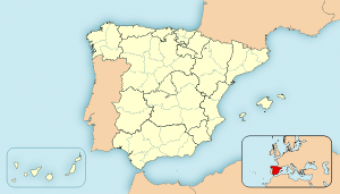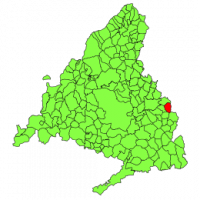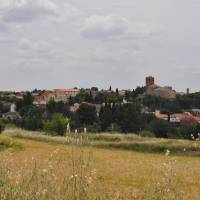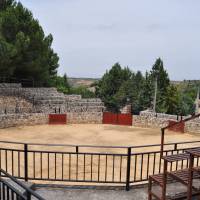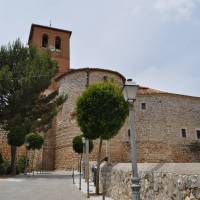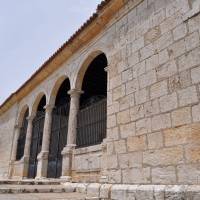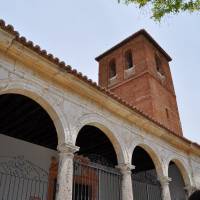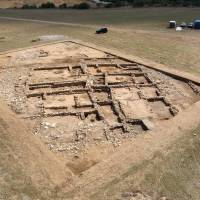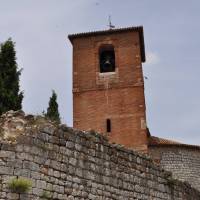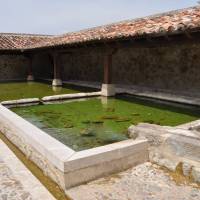This is an old revision of the document!
Table of Contents
SANTORCAZ
Location of the Municipality
 Situado en un paraje de Campiñas al este de la Comunidad de Madrid, conocido como La Alcarria de Madrid. El municipio se encuentra ubicado sobre el páramo de la Alcarria.
Situado en un paraje de Campiñas al este de la Comunidad de Madrid, conocido como La Alcarria de Madrid. El municipio se encuentra ubicado sobre el páramo de la Alcarria.
It Belongs to the judicial Alcalá de Henares, the countryside of County Henares, Madrid province.
Neighboring Municipalities
North: Los Santos de La Humosa
West: Anchuelo
East: Pioz and Pozo de Guadalajara
South: Corpa and Pezuela de Las Torres
Geographic Data
Area: 28,14 Km²
Altitude: 878 m
Latitude: 40°28’ 29’ ’’N
Longitude: 3°13’48’’ O
Resources Catalog
Natural Resources
| Name | Classification | Description | Other Observations |
|---|---|---|---|
| Livestock trails | Livestock trails | Five branches Santorcaz track to start from all directions. We communicate with Anchuelo, Corpa, y Pioz (Guadalajara). | |
| Mount “Santorcaz Station” | Reserved and protected Mount: Mount managed | This is land or scrubland mount located on the Monitoring Station Marina, east of the municipality. | Total Area: 185 ha. |
| Pinar de la Dehesa | Places, places of natural interest traditionally valued | It has been conditioned as a recreation area with benches and tables. | |
| Fauna | Fauna and ornithology | Foxes, hares, rabbits, partridges, wild boars, wild cats, booted eagles, owls, owls, hawks, kestrels and kites. | Endangered Birds: eagle. Birds are sensitive to habitat disturbance, little bustard and golden eagle. Threatened by the Regional Catalog: Montagu's harrier, peregrine falcon and owl. |
| Hunting | Huntin g | Abundant small game in the city | partridge, rabbit. |
Cultural Resources
| Name | Classification | Description | Other Observations |
|---|---|---|---|
| Church of Saint Torcuato | RTPP Religious Culture: Properties. | The building of the thirteenth century Romanesque tradition but humble masonry based building with rows of brick, which together with its triple-header Mudejar apse, makes it one of the finest examples of Moorish architecture in Madrid. The rest of the church is from the sixteenth and seventeenth centuries, even after the collapse of much of the building in 1951 had to be built in many ways. The porch was built in 1614. Contains a baroque altarpiece (S. XVII). | In the style of many scattered mainly in the north and east of the province of Madrid. Highlights the main apse, high-volume, which took as one of the units of the fortified defense. Inside you can admire paintings come out of the workshop of Juan de Arellano, a native of the village. |
| Hermitage of the Soledad | RTPP Religious Culture: Properties. | Square building built in 1681 on an ancient shrine that existed in 1575. | |
| Hermitage of Orcalez | RTPP Religious Culture: Properties. | Early sixteenth century. Erected at the expense of an archdeacon of the Cathedral of Toledo, possibly on the ruins of a mosque. Rectangular with an apse, contains gothic elements. | Is currently under reconstruction. Located at the foot of the hill of the Watchtower Arabic. The Orcalez Virgin is the patroness of the villa. |
| Altarpiece of the Church Saint Torcuato | RTPP Religious Culture: Not Properties. | Baroque altarpiece, the mid-seventeenth century, which contains four canvases of the painter Francisco Camilo. | |
| Village Carpetano del Llano de la Horca | RTPP Cultural and Civil: Properties. | The Llano de la Horca is a reservoir of the Second Iron Age that was inhabited between centuries III and a.C. by Carpetan, pre-Roman people of the Iberian Peninsula, south of the Celts, which extended over the territories which now occupies almost the entire Community of Madrid and Castilla-La Mancha. The village has a footprint of about 10 hectares and its catchment area would be between 5 and 7 km. | They have also appeared coins, plates decorated, brooches, carders, arrowheads, pottery numerous fragmented (pots and storage jars), fusayolas, millstones, tweezers and needles of bone and bronze. The objectives of the archaeological project started in 2001 include the creation of an archaeological park near the urban enclave Santorcaz, which would facilitate their management. |
| The Castle of Torremocha | RTPP Cultural, Military: Real Estate. | Raised in the last third of the fourteenth century by Archbishop Pedro Tenorio, who built another castle on the previous one does not have any reference documents. The floor of the enclosure is oval, being the only southern right side. Its walls are articulated in plans that fit the edge of the platform on which it is located. In some of its angles are available towers. Its dimensions are 110 meters from north to south and 90 meters from east to west. His canvases, currently topped, have an average thickness of 1.6 meters. In addition there is a walled castle of seven towers are preserved differently bill have been built at different times. | During the fourteenth and fifteenth centuries the Archbishop of Toledo building control and strengthen defenses against the various vicissitudes of history, hence the different gear types that have the towers of the castle grounds. During the government of Archbishop Carrillo (1445-1482), the castle, which until then had been the residence of the archbishops palace, prison became clerics, their stays through eminent personalities like Cardinal Cisneros and princess of Eboli and others . On the other hand include the church of San Torcuato, apparently associated with the founding of the castle, which is attached to the canvas from the wall and one of its towers. Is owned by the City Council. |
| Santorcaz Tower of (Arabic watchtower) | RTPP Cultural and Civil: Properties. | Tower Arab Emirate time (centuries IX and X). Formed by a small fortress rectangular tower of which is just over five feet tall in one of its sides and angles. Around it has found abundant ceramic Arabic. | Is free, take M-213 road that leads to Santorcaz Anchuelo, and before reaching the latter town, is on our left the abandoned chapel of Our Lady of Hortaleza, stands beside the mountain called Cuesta of the turret on which the tower sits. |
| Fachada del Hospital de Pobres | RTPP Culturales Civiles: Inmuebles. | En 1627 se construyó la fachada de uno de los 2 edificios del Hospital de pobres, fundado a principios del siglo XVI. La portada fue financiada a cargo de la testamentaría de un difunto del pueblo. | |
| Lavaderos | RTPP Culturales Civiles: Inmuebles. | Fueron construidos a finales del siglo XIX y recientemente han sido restaurados. | Cruzar la M-213 para acceder a ellos. |
| Fuentes | RTPP Culturales Civiles: Inmuebles. | La fuente de la Plaza de la Constitución es de 1919. De las cinco fuentes existentes en el Siglo XVI, sólo se conserva la conocida como Caño Alto, extramuros de la villa. | |
| Plaza de Toros | RTPP Culturales Civiles: Inmuebles. | Bonita pequeña plaza de toros de piedra, que aprovecha el desnivel donde se emplaza, para situar el graderío. | Se sitúa debajo del ábside de la Iglesia de San Torcuato, formando un paisaje pintoresco. Importante potencial para todo tipo de eventos además de los taurinos. |
| Comidas típicas | Folclore gastronómico | Dulces: repápalos, roscas y torrijas. Pisto. | |
| Rodaje de “Crónicas de un pueblo” | Hechos Históricos Populares | “Crónicas de un pueblo”, serie que rodó Antonio Mercero para Televisión Española, narraba la vida cotidiana y los problemas de un pueblo de Castilla, Puebla Nueva del Rey Sancho, aldea ficticia, ya que en realidad la serie fue grabada en Santorcaz, lo que dio fama al pueblo. | Existe una calle del pueblo llamada “Calle de Televisión Española”. La serie comenzó a emitirse en 1971 y permaneció tres años en antena con gran éxito. La serie, ideada por el Almirante Carrero Blanco, llevaba una fuerte carga ideológica a favor del régimen. |
| Princesa de Éboli | Personajes históricos relevantes | Ana de Mendoza de la Cerda, princesa de Éboli, condesa de Mélito y duquesa de Pastrana, (Cifuentes, 1540 - Pastrana, 1592) fue una aristócrata española. La princesa fue encerrada por Felipe II en 1579, primero en el Torreón de Pinto, luego en la fortaleza de Santorcaz y privada de la tutela de sus hijos y de la administración de sus bienes, para ser trasladada en 1581 a su Palacio Ducal de Pastrana, donde morirá atendida por su hija menor Ana de Silva . | Tuvo conflictos con Teresa de Jesús, y participó de intrigas en la corte de Felipe II que le costaron su encierro: Tras quedar viuda, dice la leyenda que fue amante del rey Felipe II, aunque esto ha sido negado por algunos autores, a la vez que de su secretario, Antonio Pérez. También se dice que Ana instigó junto al secretario del rey la muerte de Juan de Escobedo en 1578, secretario de Juan de Austria y hermano del rey, logrando la aquiescencia del rey al convencerlo de unas supuestas intrigas de Escobedo, quien en realidad había descubierto sus amores con el secretario del rey y seguramente lo denunció al monarca. |
| Cardenal Cisneros | Personajes históricos relevantes | Francisco Jiménez de Cisneros cuyo nombre de pila era Gonzalo más conocido como el Cardenal Cisneros. Tras el fallecimiento de su padre consigue el arciprestazgo de Uceda, enfrentándose con el arzobispo de Toledo, lo que significó el encarcelamiento en Santorcaz de Don Gonzalo por el arzobispo Carrillo durante algunos años. | A pesar de su reclusión, Cisneros no renunció a su cargo, en el que fue mantenido por el cardenal Gónzalez de Mendoza, aunque el encierro debió de durar poco tiempo según se deduce en algunas biografías, pues poco después, en 1478, Cisneros era capellán mayor de la catedral de Sigüenza. |
| Santísimo Cristo de la Fe | Fiestas | En septiembre durante casi una semana. Festejos religiosos y populares. El día 14 su Hermandad celebra misa cantada por una coral y procesión del Cristo acompañada de la banda de la Brigada Paracaidista. Día 18 misa en honor de los paracaidistas fallecidos en servicio, y homenaje en la lápida de la ermita de la concepción. Días 16 y 17 se celebran toros (desde el año 1619). | Destaca también las “rondas”, celebradas por la noche al acabar el baile. Son cuatro: la de solteras, la de casadas, la de solteros y la de casados. |
| San Antón | Fiestas | Noche del 16 de enero. Los vecinos se reúnen en hogueras para quemar objetos en honor del santo para que proteja a los animales, importantes para las labores del campo. | |
| San Roque | Fiestas | 15 de agosto. Romería hasta la ermita de San Roque donde se celebra misa. | |
| Subasta del Ramo | Fiestas | Diez días antes del miércoles de ceniza. Se celebra colecta entre los vecinos, los cazadores salen a cazar y las mujeres preparan roscas. Todo es subastado con destino a la Iglesia. | |
| San Torcuato y San Isidro | Fiestas patronales | El 15 de mayo. Ya existía en 1583, y a partir de 1627 y por mandato del Cardenal Gaspar de Quiroga, se viene celebrando conjuntamente con San Isidro. Misa y procesión en honor de San Torcuato. Encierros y corridas de toros, baile y más actividades. | |
| Virgen de Orcalez | Fiestas patronales | 8 de septiembre. Se celebra desde 1673. Imagen de la virgen (patrona del pueblo) es sacada en procesión por las mujeres de su Cofradía. |
Tourist Services
| Name | Classification | Description | Other Observations |
|---|---|---|---|
| La Casona de Éboli | Hotels | Hotel Rural with 6 well-appointed rooms. SPA has. Make business meetings. | C/ Embudo, 6 - Phones: 918 840 472 / 609 109 797 www.casonaeboli.com |
Other Services
| Name | Classification | Description | Other Observations |
|---|---|---|---|
| Gas Station of Robledal | Service Station | Avenida Urba,1 - Villalbilla - Phone: 918 859 967 | |
| Julio Muñoz Ranz | Service Station | El Gurugú, 28810 - Villalbilla - Phone: 918 834 122 |
Transports and Communications
| Name | Classification | Description | Other Observations |
|---|---|---|---|
| Line 275 | Bus | Alcalá de Henares - Los Santos de La Humosa - Alcalá de Henares | Monday to Friday 06:50h. to 21:30h. |
| Saturday from 10:00h. to 21:00h. | |||
| Sunday and Public Holiday from 10:00h. to 22:00h. | |||
| Alcalá de Henares - Los Santos de La Humosa - Alcalá de Henares | Monday to Friday 06:50h. to 21:30h. | ||
| Saturday from 10:00h. to 21:00h. | |||
| Sunday an Public Holiday from 10:00h. to 22:00h. | |||
| Phone: 918 880 021 | |||
| Line 279 | Bus | Madrid (South Station)- Sacedón | Monday to Friday 15:00h. |
| Saturday 11:30h. | |||
| Sunday and Public Holiday 08:00h. | |||
| Sacedón- Madrid (South Station) | Monday to Friday 07:15h. | ||
| Saturday 07:15h. | |||
| Sunday and Public Holiday 18:00h. | |||
| Phone: 918 880 021 | |||
| Point of Information http://www.ctm-madrid.es | |||
| Intermunicipal Transport Lines | http://www.ctm-madrid.es/servlet/RedTransServlet?xh_TIPO=32&xh_ACCION=0&xh_TIPO_SEL=T&CODPANTALLA=12&xh_CLAVE=136000%23Santorcaz&x=32&y=1 | ||
Routes
| Nombre | Clasificación | Descripción | Otras Observaciones |
|---|---|---|---|
| Northern Route | Natural Itineraries | Sale of the Ermita de la Soledad in the way of Guadalajara, leads to the Plain of the Gallows, crosses the valley of the Arroyo de las Fuentes, to the Arab watchtower. In the fall you can see the ruins of the Chapel of Orcalez, laundry, Pilon of Infectious and fountain Cano Alto. | 3 hours. |
| Southern Route | Natural Itineraries | Natural Leaving Pezuela Road, continue along the Elm Sapar and to take up the Way of the Bulls. At the junction with Road north to Nuevo Baztán we reach the village. | 2 hours. |
Links of Interest
* MAPS: Resources Map of the municipality.
* ROUTES: Routes and waypoints GPS of the World.
* WEBSITE: City Council Website
|
|
|
|

